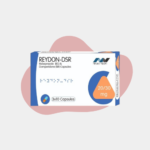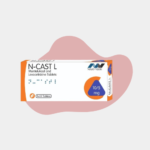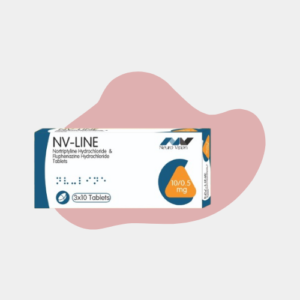Description
PANTODONE-DSR 40-30 MG CAPSULE
Explanation of the key aspects of Pantoprazole and Domperidone, especially regarding their roles in gastrointestinal treatments.
—
Pantoprazole:
Mechanism of Action (How it works): Pantoprazole is a proton pump inhibitor (PPI). The proton pump is an enzyme found in the parietal cells of the stomach. This pump is responsible for secreting hydrogen ions (H+) into the stomach, which combine with chloride ions to form hydrochloric acid (HCl), or stomach acid.
Pantoprazole works by binding to this proton pump and irreversibly inhibiting its activity. This leads to a significant reduction in the production of stomach acid. Since stomach acid is involved in many gastrointestinal issues like ulcers, acid reflux, and gastritis, Pantoprazole helps in healing these conditions and reducing symptoms like heartburn, indigestion, and irritation of the esophagus.
Uses:
GERD (Gastroesophageal Reflux Disease): A condition where stomach acid flows back into the esophagus, causing discomfort and damage. Pantoprazole helps by reducing stomach acid production.
Peptic Ulcers: These are sores that form on the lining of the stomach or duodenum due to excessive stomach acid. Pantoprazole helps in healing ulcers by reducing acid and providing relief from pain.
Zollinger-Ellison Syndrome: A rare condition where the stomach produces excessive acid due to tumors in the pancreas or duodenum.
Helicobacter pylori eradication (in combination with antibiotics): H. pylori bacteria can cause ulcers, and reducing acid helps in the effectiveness of antibiotics.
Pharmacokinetics (How the body processes it):
Absorption: Pantoprazole is absorbed rapidly after oral intake, but it is subject to first-pass metabolism in the liver (this means some of the drug is broken down in the liver before it reaches the bloodstream). However, its bioavailability (how much of the drug is available to have an effect) remains moderate.
Half-Life: Pantoprazole has a short half-life of about 1 hour, meaning the drug is cleared from the bloodstream quickly. However, its effect lasts much longer, providing sustained suppression of acid production.
Metabolism: Pantoprazole is metabolized in the liver through enzymes such as CYP2C19 and CYP3A4, which are part of the cytochrome P450 system.
Excretion: The drug is mainly excreted via the urine, and a small fraction is eliminated in the feces.
Side Effects: While Pantoprazole is generally well-tolerated, some side effects may include:
Common: Headache, diarrhea, abdominal pain, nausea, and flatulence.
Serious (long-term use): Osteoporosis, due to decreased calcium absorption, vitamin B12 deficiency, and hypomagnesemia (low magnesium levels). Long-term suppression of stomach acid can also increase the risk of gastrointestinal infections like Clostridium difficile.
—
Domperidone:
Mechanism of Action (How it works): Domperidone is a dopamine antagonist. Dopamine is a neurotransmitter that plays several roles in the body, including inhibiting the movement of food through the digestive system.
By blocking dopamine receptors in the gastrointestinal tract, Domperidone increases gastric motility, meaning it helps food move from the stomach into the intestines more efficiently. This helps in treating conditions where the stomach takes too long to empty its contents, such as gastroparesis (delayed stomach emptying).
Domperidone also has antiemetic (anti-nausea) effects. By blocking dopamine receptors in the vomiting center of the brain, it prevents nausea and vomiting, making it useful in conditions where nausea is a major symptom.
Uses:
Nausea and Vomiting: Domperidone is effective at treating nausea caused by various conditions, including chemotherapy and certain gastrointestinal disorders.
Gastroparesis: It helps by improving the movement of food through the stomach, which is especially useful in diabetics who may suffer from this condition.
Functional Dyspepsia: A condition that causes indigestion and bloating without any obvious cause.
Improvement of Gastrointestinal Motility: It is used to speed up the emptying of the stomach and reduce bloating.
Pharmacokinetics:
Absorption: Domperidone is absorbed well from the digestive tract, but its bioavailability is limited due to first-pass metabolism in the liver.
Half-Life: The drug has a half-life of 7–9 hours, meaning it stays in the body longer, which provides prolonged relief from nausea and motility issues.
Metabolism: It is metabolized by CYP3A4 enzymes in the liver.
Excretion: The drug is primarily excreted in the feces, with a small amount being eliminated in the urine.
Side Effects: Common side effects of Domperidone include:
Dry mouth, headaches, dizziness, and abdominal cramps.
Rare, but serious side effects include arrhythmias (irregular heartbeats) when used at high doses or in patients with pre-existing heart conditions.
—
Combination Therapy (Pantoprazole + Domperidone):
The combination of Pantoprazole and Domperidone is particularly effective in treating GERD and other gastrointestinal disorders where both acid reflux and delayed gastric emptying are present.
Pantoprazole reduces stomach acid production, helping to heal ulcers and prevent acid reflux.
Domperidone enhances the motility of the stomach, improving food transit time and alleviating symptoms like bloating and nausea.
Pregnancy Safety:
Both Pantoprazole and Domperidone are classified as Category C for pregnancy, meaning there is limited evidence on their safety during pregnancy. They should be used only when the benefits outweigh the potential risks to the fetus. It is essential for pregnant women to consult with a healthcare provider before using these drugs.
Conclusion:
Pantoprazole helps control stomach acid, which is critical for healing ulcers and preventing acid reflux.
Domperidone improves gastric motility, which helps with symptoms like nausea, vomiting, and bloating.
This combination can provide comprehensive relief from gastrointestinal conditions that involve both excessive acid production and impaired stomach emptying. However, it’s important to use these medications under medical supervision, especially in vulnerable populations like pregnant women.








Reviews
There are no reviews yet.